At least the best one I have seen so far. After giving a lecture on LEDs yesterday I finally unpacked and tested my latest buy – the clear E27 LED bulb LEDARE from IKEA.

(Image linked from IKEA’s homepage.)
The specs of this LED bulb are not overly impressive, with an efficacy of a mere 50 lm/W it is about as efficient as a compact fluorescent lamp and with its 400 lm it corresponds to a 30 W to 40 W light bulb. Running at 8.1 W this means that it will consume only 20-25% of the electricity of a comparable incandescent bulb.
But what really amazed me was the high quality of the light. It is a nice warm white, stated as 2700 K on the package, much comparable to the best compact fluorescents I have seen and close to an incandescent – if this is what you are after. Not only is the visual impression of the light very good, also the color rendering is very good.
| socket | E27 |
|---|---|
| size | 59 mm diameter, 119 mm length |
| voltage | 220 V – 240 V |
| power | 8.1 W |
| output | 400 lm |
| color temperature | 2700 K |
| CRI | > 85 |
| lifetime | 20000 h |
| on/off switching | 100000 |
| manufactured in | India |
| price | SEK 99 (EUR 12, Nov. 2012) |
So, how does IKEA accomplish the pleasant spectral composition of the light bulb? I taught my students that the best way to do this is by using the correct blend of phosphors, like in compact fluorescents. But then there was a distinct red appearance when I looked closely at the LED bulb. The LEDs themselves are hidden underneath a light-spreading plastics cone inside the clear glass dome of the bulb – interestingly this cone is screwed to the bulb, not glued as you might expect.
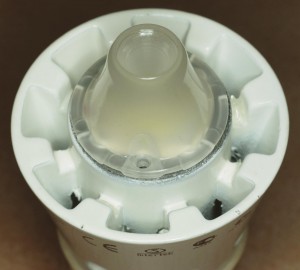
However, the glass dome itself is glued to the solid metal lamp socket which serves as heat sink for the internal converter and the LEDs themselves. I was not able to remove it without breaking, but the rest of the bulb remained undamaged. So how does it look under the hood?
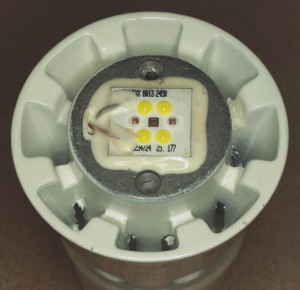
The solid cast metal socket carries a COB (chip-on-board) unit with 6 LEDs:
- four white LEDs, being standard blue LEDs with a phosphor-containing blob of resin on top
- and two big red-emitting LEDs in between.
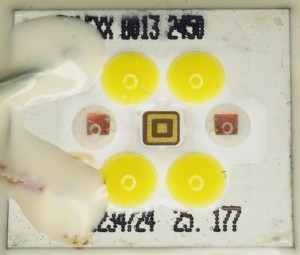
The LED chips are connected in a string with a voltage drop of 16.5 V. One interesting fact about the red LEDs is that there are two bond wires from the board to the front side of the LED chip.
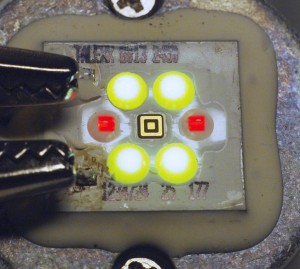
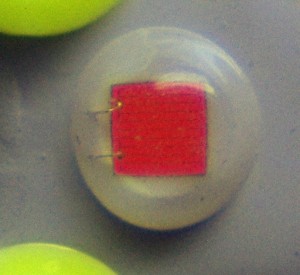
A short inquiry on the internet revealed that the COB module is made by the company Tridonic. More information can be found on their homepage.

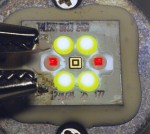
Thanks a lot for sharing your experience.
I’ve bought this bulb and it appears it is a little taller than standard/incandescent E27 bulbs, thus not fitting into my wall light;
I was able to remove the glass dome of the bulb with a bicycle inner-tube (chambre a air), surrounding the bulb like a big elastic , in order to distribute my pressure equally on the glass surface.
Now with the glass dome removed the bulb is a little shorter than incandescent e27 and it fits everywhere.
Hope this helps anyone who wants to remove the glass cleanly.
Thanks for this tip!
Indeed I also had trouble removing the glass dome when inspecting the interior of the bulb – I ended up with a lot of small pieces of glass.
Uwe.
Thanks for the LED teardown, very interesting.
The Tridonic link doesn’t work anymore, what TALEXX model number is it, I coudln’t find it at their website? Is it a custom model not shown at their website?
It appears to be a custom model, but it is very similar to the ones shown on their website. I changed the broken link to point just to the Tridonic homepage
Very interesting article indeed.
I have recently (may 2014) purchased one of the newest IKEA LEDARE bulbs, a 16.5W model boasting 1,000 lumens. It is quite cumbersome, but the intensity and quality of light is stunning. I suspect they use the same trick (mostly white LEDs and a few red LEDs) to even out the color spectrum (they say the CRI to be over 87!). I just have some concern about heat management: no fins, just the ceramic body to extract calories.
If anybody has a go at this model, I would be most interested to know how it is constructed…
I haven’t seen these here in Sweden yet – once I get hold of one, I’ll have a look under the hood.
Now I have purchased and opened one of these 1000 lm giants. See my latest post (2014-06-11).